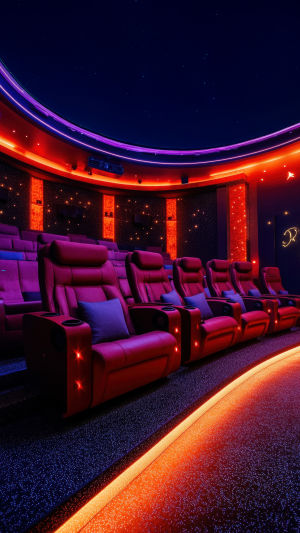Have you ever been completely swept away into a film, feeling as though you were part of the world unfolding on screen?
That sense of immersion is largely thanks to advancements in 3D technology and IMAX—two cinematic innovations that have drastically transformed how we experience films.
These technologies don't just add depth to the image; they pull us into the action, creating a more emotional and tactile experience.
In this article, we'll explore how 3D and IMAX technologies have evolved to offer audiences deeper levels of engagement. By looking at specific examples like "Avatar" and "Inception", we'll discuss how these technologies have influenced visual storytelling, making us feel like we're part of the narrative itself.
Let's dive in and discover how these cutting-edge technologies turn an ordinary movie into an extraordinary journey.
<h3>The Impact of 3D Technology: Bringing Worlds to Life</h3>
When 3D technology was first introduced to cinemas, it was a novelty—something that added a little "wow" factor but didn't always serve the film in a meaningful way. However, in recent years, 3D has evolved into a powerful storytelling tool.
A standout example is James Cameron's "Avatar" (2009), where 3D wasn't just a gimmick but an integral part of the film's immersive experience.
In "Avatar", the 3D technology was used to create the Pandora world—one that felt tangible and alive. From the sweeping jungles to the floating mountains, 3D made everything feel real. We weren't just looking at a flat image; we were transported into a three-dimensional space that surrounded us.
The depth provided by 3D allows us to experience the action as if we were standing right there, feeling the intensity of the serenity of the alien landscapes.
The use of stereoscopic imagery in 3D films adds layers to the visual experience, enhancing spatial awareness.
This means that, instead of seeing objects as flat images, we can perceive the space around them. In "Avatar", this was crucial in creating an engaging environment that viewers could explore through the characters.
By drawing us into the depth of the setting, 3D technology enhances the emotional stakes—making us more invested in the characters' journey and struggles.
<h3>IMAX: Expanding the Visual Experience</h3>
While 3D enhances the sense of depth and space, IMAX takes this experience to a whole new level.
IMAX screens are much larger than traditional ones, and the technology also involves specialized projectors and sound systems, making the visuals more vivid and the audio more immersive. But it's not just the size that makes IMAX so captivating—it's the way it transforms the entire cinematic experience.
Take Christopher Nolan's "Inception" (2010) as an example. The film's use of IMAX film stock created a visual spectacle that added layers of intensity to the already mind-bending narrative. In the sequences where the world itself begins to fold, the IMAX format allowed for expansive, panoramic shots that enveloped the viewer.
Whether it was the dream heist or the gravity-defying fight scenes, IMAX's large frame and clarity brought us into the very heart of the action.
IMAX also enhances the sense of space in a film. It's not just about size; it's about how the visuals are framed and presented. When watching in an IMAX theater, the sheer scale of the images makes you feel as though you're right there in the scene, witnessing the action unfold in front of you.
This increased visual immersion creates a stronger emotional connection with the film, intensifying every moment from a quiet conversation to an explosive chase.
<h3>Spatial Awareness and Emotional Engagement</h3>
The immersive qualities of 3D and IMAX aren't just about creating stunning visuals—they also play a huge role in how we emotionally connect with the story.
When we experience a movie in 3D or on an IMAX screen, the increased spatial awareness makes us feel like we are physically inside the film's world. This sense of presence allows us to feel the tension of a chase, the quiet anticipation of a conversation, or the awe of discovering a new world.
The larger-than-life visuals draw us into the character's journey, making us more emotionally invested in their struggles and victories.
Consider the emotional impact of the 3D imagery in "Avatar"—as the camera zooms in on the characters and we see their facial expressions in greater depth, we are better able to connect with their emotions. Similarly, in IMAX, the sweeping shots of landscapes or intense action scenes amplify our feelings of awe or fear.
We become more connected to the story, as we feel like active participants rather than passive observers.
<h3>Technical Challenges and Future Possibilities</h3>
Of course, the implementation of 3D and IMAX technologies doesn't come without challenges. One significant issue with 3D is the potential for visual fatigue or discomfort, especially during long films.
Some viewers may also find that 3D glasses interfere with the sharpness of the image. However, new advancements in digital projection and light-field technology are helping to address these issues, promising even better visual clarity in future 3D films.
IMAX, on the other hand, requires the use of specialized equipment, and the process of shooting and editing in IMAX is more complex than standard filmmaking. However, as filmmakers continue to experiment with digital IMAX projection and other innovations, we can expect to see even more visually breathtaking experiences in the years to come.
Looking ahead, virtual reality (VR) and augmented reality (AR) could further extend the immersive potential of both 3D and IMAX. Imagine a film where you could not only see but also interact with the environment around you, enhancing the emotional and sensory experience even further.
<h3>Conclusion: A New Era of Immersion</h3>
Both 3D and IMAX technologies have fundamentally changed the way we watch movies. They create a sense of immersion that pulls us into the world of the film, making us feel as though we're part of the action.
With films like "Avatar" and "Inception" showing the power of these technologies, we've only scratched the surface of what's possible. As the technology continues to evolve, it's clear that the future of cinema will be even more immersive, offering experiences that make us feel as though we're truly living inside the story.
So, the next time you head to the theater, take a moment to appreciate how 3D and IMAX have transformed the way we experience films. Who knows what incredible breakthroughs are just around the corner?





